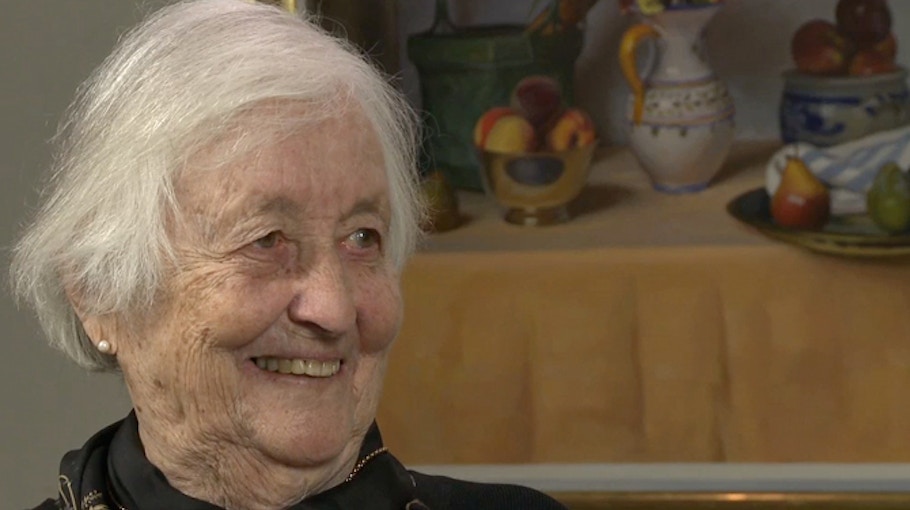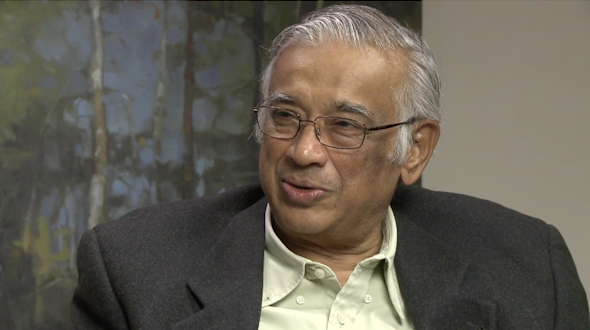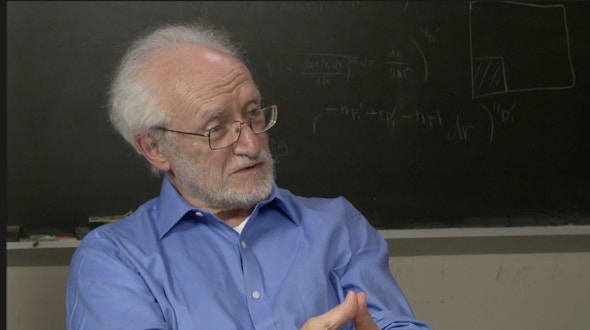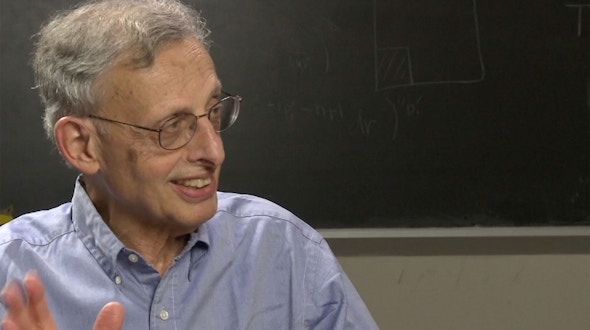Cathleen Morawetz
- Highlights (4:24)
- Childhood in Ireland (3:27)
- The path to mathematics (5:20)
- Discovering mathematics (2:53)
- Becoming a mathematician, first job (5:17)
- Finishing college and actuarial job (3:36)
- Time at MIT (2:17)
- Coming to the United States (3:29)
- The Courtant Institute (2:37)
- Coming to the Courant Institute (3:51)
- Working with Courant (3:23)
- Roots of the Courant Institute (5:07)
- Women in mathematics (1:29)
- Managing school, work, and kids (3:27)
- Few women in mathematics (9:02)
- Going to MIT after PhD (6:51)
- Mixed equations and Lipman Bers (5:25)
- Favorite work (2:17)
- Mathematical work (3:17)
- Hermann Weyl (1:53)
- Current work (1:44)
- Computation (1:41)
- Pure vs. Applied mathematics (2:11)
- Pure and applied mathematicians (3:42)
- Adminstrative positions at Courant (6:02)
- The Courant Institute during the McCarthy era (1:53)
- Being a Trustee at Princeton (4:14)
- Presidency of the AMS (3:20)
- On prizes (3:24)
- National Academy of Sciences (1:17)
- Role models and relatives (7:55)
- Family background (4:37)
- Synge, Courant, and feminism (5:07)
- Mathematical influences (2:09)
New York, N.Y. — In her office at New York University’s Courant Institute for Mathematical Sciences, sitting on a sofa piled with mail, journals, notepads and her telephone, Cathleen Morawetz spoke with pleasure of both her President’s Medal and her first great-grandchild.
Of the former, awarded by President Clinton in 1998 to honor her “pioneering advances in partial differential equations and wave propagation resulting in application to aerodynamics, acoustics,and optics,” she said modestly: “I was quite proud to get it.” Of the latter, she said bluntly: “I’d like another.”
Morawetz was surrounded by signs of a recent move — stacked boxes, unfilled bookshelves, a Persian rug still rolled up, a desk piled with yellowed handwritten correspondence and files encroaching on the computer — a collage representing her 65 years at the Courant Institute, including stints as associate director and director.
“It’s a mess!” she said, clearly more inclined to grapple with the unsolved number theory problem staring down at her from the blackboard than with the chaos of her office. Having retired in 1991 at age 68, she still works a couple of hours a day, with her feet up on the couch and paper, pen and pencil at the ready.
Morawetz came by her mathematics honestly, as they say. Her father was John L. Synge, the esteemed professor of applied mathematics, and her mother, Eleanor Allen, had some mathematical training as well. Her parents encouraged her interest, though her father joked that if she became a mathematician, “We might fight like the Bernoulli brothers.” For her part, Morawetz has been known to quip: “Maybe I became a mathematician because I was so crummy at housework.”
In 1945, Morawetz received a bachelor’s degree in mathematics from the University of Toronto, and in 1946 she earned a master’s degree from the Massachusetts Institute of Technology. She married the chemist Herbert Morawetz, who worked for the Bakelite Corporation, and followed him to New Jersey after he transferred to the factory in Bound Brook. Richard Courant gave Morawetz her first job at NYU, which entailed editing the book “Supersonic Flow and Shock Waves,” by Courant and Kurt Friedrichs. Her task consisted mainly of correcting the English, but it was an invaluable and immersive learning experience. “It formed the backbone of my career,” she said. With Friedrichs as her doctoral adviser, and with two young children, she completed her Ph.D. in 1951 with a thesis on imploding shock waves. “It looked like an extremely impractical thing that nobody would ever be interested in,” she said.
But the mathematics of transonic flow and shock waves became one of her main research interests, with wide-ranging applications. Her first breakthrough involved explaining a phenomenon that hadn’t been fully understood. “It was a proof of a theorem, but the ideas in the theorem were really due to somebody else,” she said, giving a characteristic nod to another early influence, Lipman Bers.
The phenomenon was this: When an airplane flies more slowly than the speed of sound, it is said to be flying subsonically. When it flies faster than the speed of sound, it flies supersonically, causing shock waves to develop and creating troublesome and costly supersonic booms. Sometimes the flow of air past an airplane’s wing is partly subsonic and partly supersonic — that is, transonic. The variation is due to compression of the air produced by wing shape, since a change in pressure, like a change in temperature, changes the local speed of sound. Engineers had designed wings to minimize shocks. But the question remained whether it was possible to eliminate shocks entirely.
Morawetz proved it was not. Airfoils could be designed for certain speeds such that the transonic transition did not create a boom. But if any of the conditions changed, if anything was perturbed — a fly landing on the wing, or the angle of the wing shifting — then the boom would occur. Smooth flow existed, but it was unstable. This was Morawetz’s “nonexistence result,” from her paper “On the Non-Existence of Transonic Flows,” published in 1956.
The subject of transonic flow remained an abiding interest, to which she often returned. In July 2002, long after retiring, she attended the joint meeting of the American Mathematical Society and the Italian Mathematical Union in Pisa, Italy. One evening, after the day’s proceedings, Barbara Keyfitz of Ohio State University invited her to join a group going out to dinner. Morawetz declined, saying she was dining with John Hunter of the University of California Davis because, as she told Keyfitz, “He has a new result and I want to understand it!” Keyfitz had heard of Hunter’s result, but she did not want to understand it. “It was about an extremely complicated shock reflective pattern,” she recalled, “and I just didn’t want it in my life.” She admired Morawetz for her willingness to sink her teeth into it, and, in hindsight, for her impeccable instincts. “It turned out she was right. Her intuition that this complicated phenomenon was a key component of the problem we were looking at was very insightful.”
“She’s not somebody I’d want to compete with, because she usually gets it right,” Keyfitz said. “But she’s not all that competitive, actually. She is extremely generous.”
The adjectives “generous” and “original” are often used to describe Morawetz. “She has a very generous way of doing mathematics,” said one of her collaborators, Walter Strauss, of Brown University. He worked with Morawetz on the second of her main interests — the mathematics of the scattering of waves, and the exponential decay of the nonlinear wave equation (and later the linear wave equation). Scattering theory investigates how waves — light, sound, electromagnetic waves or quantum waves — behave when they interact with a body or barrier, or self-interact in a nonlinear way.
The work Morawetz did with Strauss on the nonlinear wave equation was tricky. But as Strauss recalled, “She had a way of coming up with idea after idea after idea. Not all of them worked. But she is fearless in saying, ‘What about this? How about that?’ Off the top of her head she had all these imaginative ideas.”
“One idea sometimes seeds the next idea,” said Morawetz. “In some sense I was a lazy scientist. I didn’t always push everything to its end. The advantage of that is, it leaves something for somebody else.”
Indeed, two terms named after her, the “Morawetz inequality” and the vaguer “Morawetz estimate,” have taken on a timeless quality she never anticipated. In fact, there is a whole series of Morawetz inequalities and Morawetz estimates, both of which refer to a general procedure for proving local energy decay to provide solutions to a large class of dispersive equations, such as those that describe the propagation of light.
“That discovery was somewhat of an accident,” said Morawetz. “Of course, many discoveries have something of an accident about them.”
Most surprising to Morawetz is the diversity of problems to which this work is currently applied — problems taken up by well-known researchers like Jean Bourgain of the Institute for Advanced Study, Terrence Tao of UCLA and Sergui Klainerman of Princeton.
“She discovered ways of getting decay estimates which are very robust, meaning they can be applied to many, many situations,” said Klainerman. “And it is for this reason that her work has been very influential. Initially she was interested in applications to scattering theory of waves outside an obstacle. But her work is now being applied to many other situations, such as global solutions to nonlinear wave equations, or stability of black holes.”
And while her past work is keeping subsequent generations of mathematicians busy, Morawetz herself is keeping busy with that number theory equation staring down at her from the blackboard in her office.
It came from Peter Sarnak, of Princeton University and the Institute for Advanced Study (formerly of Courant), who was seeking input on a conjecture he was investigating regarding a known problem in the theory of the Riemann zeta function, called the Lindeloff Hypothesis.
“I was delighted that Cathleen, who is one of the finest analysts in the world, took on this challenge,” said Sarnak. “While she has not as yet solved the problem, she has developed a number of critical insights and ideas.”
Morawetz gave up on the problem after a few years. “But then,” she said, “I was looking for something to do, so I decided to try it again.”
“Her courage and determination in tackling a hard problem relentlessly are characteristic of the finest problem solvers,” Sarnak said. “There are few people who have the courage to tackle a hard problem head-on. Cathleen is one of those few, and that she is doing so with such tenacity and at a mature age is a great inspiration for researchers of all ages and in any field.”
Morawetz has also been a great inspiration for female mathematicians in particular — not only in her research career, but also in her administrative roles. In addition to her Courant directorships, she served as president of the American Mathematical Society from 1995 to 1996.
“She was unstoppable,” said Irene Gambia of the University of Texas, another of Morawetz’s collaborators. “She raised four children, and she understood that our motherhood was integrated totally in our professional life.”
Morawetz said she could not have done it had she not been at Courant. As she once commented, “I’ve led a protected life at the Courant Institute and I know it.” She divulged another secret: she had very good help. In her best year, she said, she had two Swedish nannies taking care of the children and doing everything around the house.
Beyond the logistics of juggling work and home, she also contended with colleagues who told her outright that she was ruining her children’s lives. Others more delicately inquired whether she worried about the kids while she was at work. To which she responded: “No. I’m much more likely to worry about a theorem when I’m with my children.”



